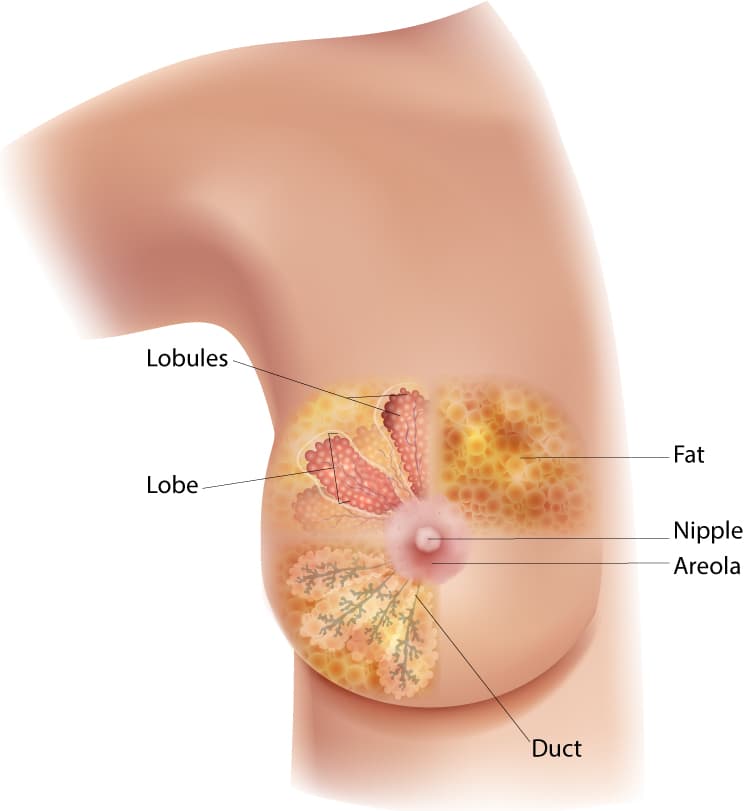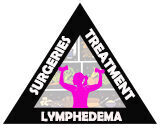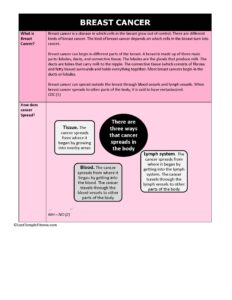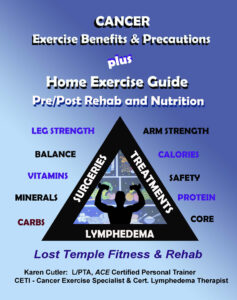Breast Cancer & Types
Your Body is Your Temple
Research, Resources & Education
Table of Contents
Breast cancer is a serious medical condition that occurs when the cells in the breasts become abnormal and begin to grow out of control. It is a complex disease with various types, including Invasive ductal carcinoma and Invasive lobular carcinoma. These two types of breast cancer are the most common forms, with each having its unique characteristics and contributing factors.
Information and pictures from National Cancer Institute unless otherwise specified
What is Breast Cancer?
Some Information & Picture from the Center for Disease Control (CDC)

- Breast cancer is a disease in which cells in the breast grow out of control.
- There are different kinds of breast cancer.
- The kind of breast cancer depends on which cells in the breast turn into cancer.
- Breast cancer can begin in different parts of the breast. A breast is made up of three main parts: lobules, ducts, and connective tissue.
- The lobules are the glands that produce milk.
- The ducts are tubes that carry milk to the nipple.
- The connective tissue (which consists of fibrous and fatty tissue) surrounds and holds everything together.
- Most breast cancers begin in the ducts or lobules.
- Breast cancer can spread outside the breast through blood vessels and lymph vessels.
- When breast cancer spreads to other parts of the body, it is said to have metastasized. (CDC)
Breast Cancer and Types Videos
YouTube Videos that help explain Breast Cancer, Types & Stages.
Disclaimer:
This is for research only and Lost Temple Fitness & Cancer does not endorse any video presented on this website.
It is advised that you ALWAYS CHECK WITH YOUR PHYSICIAN for a proper diagnosis and treatment plan.
How Cancer Spreads

Stage Groups
In breast cancer, stage is based on the size and location of the primary tumor, the spread of cancer to nearby lymph nodes or other parts of the body, tumor grade, and whether certain biomarkers are present. To plan the best treatment and understand your prognosis, it is important to know the breast cancer stage. (NCI)

Risk & Protective Factors
Risk Factors
- A personal history of benign (non-cancer) breast disease.
- A family history of breast cancer in a first- degree relative (mother, daughter, or sister).
- Inherited changes in the BRCA1 or BRCA2 genes or in other genes (such as PALB2) that increase the risk of breast cancer.
- Breast tissue that is dense on a mammogram.
- Exposure of breast tissue to estrogen made by the body. This may be caused by:
- Menstruating at an early age.
- Older age at first birth or never having given birth.
- Starting menopause at a later age.
- Taking hormones such as estrogen combined with progestin for symptoms of menopause.
- Treatment with radiation therapy to the breast/chest.
- Drinking alcohol.
- Obesity.
Of all women with breast cancer, 5% to 10% may have a germline mutation of the genes BRCA1 and BRCA2.
- Specific mutations of BRCA1 and BRCA2 are more common in women of Jewish ancestry.
- The estimated lifetime risk of developing breast cancer for women with BRCA1 and BRCA2 mutations is 40% to 85%.
- Carriers with a history of breast cancer have an increased risk of contralateral disease that may be as high as 5% per year.
- Male BRCA2 mutation carriers also have an increased risk of breast cancer.
- Mutations in either the BRCA1 or the BRCA2 gene also confer an increased risk of ovarian cancer or other primary cancers.
- Once a BRCA1 or BRCA2 mutation has been identified, other family members can be referred for genetic counseling and testing. (NCI)
Protective Factors
Protective factors and interventions to reduce the risk of female breast cancer include the following:
- Estrogen use (after hysterectomy).
- Exercise.
- Early pregnancy.
- Breast feeding.
- Selective estrogen receptor modulators (SERMs).
- Aromatase inhibitors or inactivators.
- Risk-reducing mastectomy.
- Risk-reducing oophorectomy or ovarian ablation. (NCI)
Types / Kinds of Breast Cancer
Information also from the National Center for Biotechnical Information (NCBI)
Mayo Clinic: Invasive lobular carcinoma, Lobular carcinoma in situ (LCIS), and Ductal carcinoma in situ (DCIS)
Ductal carcinoma in situ (DCIS)
DCIS is considered a precursor lesion for the subsequent development of invasive carcinoma with a high-risk index factor than that expected in women without.
- DCIS Death due to DCIS is extremely rare, but death occurring after initial diagnosis of DCIS is either because of undetected invasive component or due to recurrence of invasive lesion after the treatment. (NCBI – Diversity of Breast Carcinoma)
- 85% of breast cancer originates in the ducts
- These cancers are considered benign, but eventually will become invasive with time
Symptoms:
- DCIS doesn’t typically have any signs or symptoms. However, DCIS can sometimes cause signs such as:
- A breast lump
- Bloody nipple discharge (Mayo Clinic: Ductal carcinoma in situ (DCIS)
Lobular carcinoma in situ (LCIS)
Lobular carcinoma in situ (LCIS) is an uncommon condition in which abnormal cells form in the milk glands (lobules) in the breast.
- LCIS isn’t cancer, but being diagnosed with LCIS indicates that you have an increased risk of developing breast cancer.
- Women with LCIS have an increased risk of developing invasive breast cancer in either breast.
- 15% of breast cancer originates in the lobules
- These cancers are considered benign, but eventually will become invasive with time.
Symptoms:
- LCIS usually doesn’t show up on mammograms.
- The condition is most often discovered as a result of a breast biopsy done for another reason, such as a suspicious breast lump or an abnormal mammogram. (Mayo Clinic: Lobular carcinoma in situ (LCIS)
Invasive Ductal Carcinoma (IDC)
The most common type of invasive breast cancer.
- It begins in the lining of the milk ducts (thin tubes that carry milk from the lobules of the breast to the nipple) and spreads outside the ducts to surrounding normal tissue.
- Invasive ductal carcinoma can also spread through the blood and lymph systems to other parts of the body.
- Also called infiltrating ductal carcinoma. (NCI – IDC definition)
- The cancer cells grow outside the ducts into other parts of the breast tissue.
- Invasive cancer cells can also spread, or metastasize, to other parts of the body.
Symptoms:
- A lump in your breast.
- Thickened breast skin.
- Rash or redness on your breast.
- Swelling in your breast.
- New pain in your breast.
- Dimpling on your breast or the skin of your nipple.
- Nipple pain.
- Inverted nipple.
Invasive Lobular Carcinoma (ILC)
A type of invasive breast cancer that begins in the lobules (milk glands) of the breast and spreads to surrounding normal tissue.
- It can also spread through the blood and lymph systems to other parts of the body.
- Also called infiltrating lobular carcinoma. (NCI – ILC definition)
- Begins in the milk-producing glands (lobules) of the breast.
- Cancer cells have broken out of the lobule where they began and have the potential to spread to the lymph nodes and other areas of the body.
- Invasive lobular carcinoma makes up a small portion of all breast cancers.
- Invasive lobular carcinoma is less likely than other forms of breast cancer to cause a firm or distinct breast lump.
Symptoms: At its earliest stages, invasive lobular carcinoma may cause no signs and symptoms. As it grows larger, invasive lobular carcinoma may cause:
- An area of thickening in part of the breast
- A new area of fullness or swelling in the breast
- A change in the texture or appearance of the skin over the breast, such as dimpling or thickening
- A newly inverted nipple (Mayo Clinic: Invasive lobular carcinoma)
Inflammatory breast cancer
Inflammatory breast cancer is a rare and very aggressive disease in which cancer cells block lymph vessels in the skin of the breast.
- This type of breast cancer is called “inflammatory” because the breast often looks swollen and red, or inflamed.
- Inflammatory breast cancer is rare, accounting for 1 to 5 percent of all breast cancers diagnosed in the United States.
- Most inflammatory breast cancers are invasive ductal carcinomas, which means they developed from cells that line the milk ducts of the breast and then spread beyond the ducts.
- Inflammatory breast cancer progresses rapidly, often in a matter of weeks or months.
- At diagnosis, inflammatory breast cancer is either stage III or IV disease, depending on whether cancer cells have spread only to nearby lymph nodes or to other tissues as well.
- Compared with other types of breast cancer, inflammatory breast cancer tends to be diagnosed at younger ages.
- More common and diagnosed at younger ages in African American women than in white women.
- Inflammatory breast tumors are frequently hormone receptor negative, which means they cannot be treated with hormone therapies, such as tamoxifen, that interfere with the growth of cancer cells fueled by estrogen.
- More common in obese women than in women of normal weight. (NCI – Inflammatory Breast)
Paget Disease of the Breast
Paget disease of the breast (also known as Paget disease of the nipple and mammary
- Paget disease) is a rare type of cancer involving the skin of the nipple and, usually, the darker circle of skin around it, which is called the areola.
- Most people with Paget disease of the breast also have one or more tumors inside the same breast.
- These breast tumors are either ductal carcinoma in situ or invasive breast cancer.
- Paget disease of the breast occurs in both women and men, but most cases occur in women
- Approximately 1 to 4 percent of all cases of breast cancer also involve Paget disease of the breast.
- The average age at diagnosis is 57 years, but the disease has been found in adolescents and in people in their late 80s
- Studies have shown that breast-conserving surgery that includes removal of the nipple and areola, followed by whole-breast radiation therapy, is a safe option for people with Paget disease of the breast who do not have a palpable lump in their breast and whose mammograms do not reveal a tumor
The symptoms of Paget disease of the breast are often mistaken for those of some benign skin conditions, such as dermatitis or eczema. These symptoms may include the following:
- Itching, tingling, or redness in the nipple and/or areola
- Flaking, crusty, or thickened skin on or around the nipple
- A flattened nipple
- Discharge from the nipple that may be yellowish or bloody
- Because the early symptoms of Paget disease of the breast may suggest a benign skin condition, and because the disease is rare, it may be misdiagnosed at first.
- People with Paget disease of the breast have often had symptoms for several months before being correctly diagnosed. (NIH NCI – Paget)
Rare Cancers – not limited to:
- Male Breast Cancer – Cancer that forms in tissues of the breast in men.
- Most male breast cancer begins in cells lining the ducts.
- It is very rare and usually affects older men.
- Medullary breast cancer
- Mucinous (mucoid or colloid) breast cancer
- Tubular breast cancer
- Adenoid cystic carcinoma of the breast
- Metaplastic breast cancer
- Lymphoma of the breast
- Basal type breast cancer
- Phyllodes or cystosarcoma phyllodes
- Papillary breast cancer
Disclaimer: The information in this book/website is for educational purposes only and has been obtained through research, publications and personal experience, and shall not be liable for incorrect information. Any mentioned publications or websites does not imply endorsement. As this industry is ever changing, I urge readers to confirm the information contained in this book/website. The author will not be liable for any injuries sustained from practicing techniques taught or for any typographical errors or omissions.
It is advised that you always check with your medical doctor or physical therapist before starting an exercise program or change in diet.
Information and pictures from National Cancer Institute unless otherwise specified




